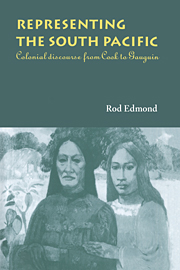Book contents
- Frontmatter
- Contents
- List of illustrations
- Acknowledgements
- 1 Introduction
- 2 Killing the god: the afterlife of Cook's death
- 3 Mutineers and beachcombers
- 4 Missionary endeavours
- 5 Trade and adventure
- 6 Taking up with kanakas: Robert Louis Stevenson and the Pacific
- 7 Skin and bones: Jack London's diseased Pacific
- 8 The French Pacific
- 9 Epilogue
- Notes
- Index
7 - Skin and bones: Jack London's diseased Pacific
Published online by Cambridge University Press: 31 October 2009
- Frontmatter
- Contents
- List of illustrations
- Acknowledgements
- 1 Introduction
- 2 Killing the god: the afterlife of Cook's death
- 3 Mutineers and beachcombers
- 4 Missionary endeavours
- 5 Trade and adventure
- 6 Taking up with kanakas: Robert Louis Stevenson and the Pacific
- 7 Skin and bones: Jack London's diseased Pacific
- 8 The French Pacific
- 9 Epilogue
- Notes
- Index
Summary
The legible evidence of western diseases on blemished native bodies haunted writing about the Pacific from the early moments of contact. Wherever Cook returned he found signs of his previous landfall on the inhabitants’ bodies, and all his efforts at controlling spread of ‘the Venereal’ were nugatory. As Captain Clerke reflected on leaving Kealakekua Bay, it was not just their commander they left behind: ‘Captain Cook did take such preventive methods as I hop'd and flatter'd myself would prove effectual… but our Seamen are in these matters so infernal and dissolute a Crew that for the gratification of the present passion that affects them they would entail universal destruction upon the whole of the Human Species.’ Not only did the cycle of infection and reinfection produced by Cook's many landfalls in the course of three voyages threaten the good order of his ships, but its physical symptoms were a palpable sign of the contaminating power of European civilization. They rebuked the explorer for his intrusion and contradicted the purity of his intentions.
At the heart of the European paradise of the South Pacific, therefore, a counter-discourse of the diseased Pacific began almost simultaneously. Western valorization of the Polynesian body augmented the significance of any blemish to its surface, and these blemishes were most frequently ascribed to sexual causes. In fact the worst forms of venereal disease were mainly avoided. The endemic island disease of yaws gave immunity to syphilis, whose symptoms it resembled.
- Type
- Chapter
- Information
- Representing the South PacificColonial Discourse from Cook to Gauguin, pp. 194 - 222Publisher: Cambridge University PressPrint publication year: 1997

